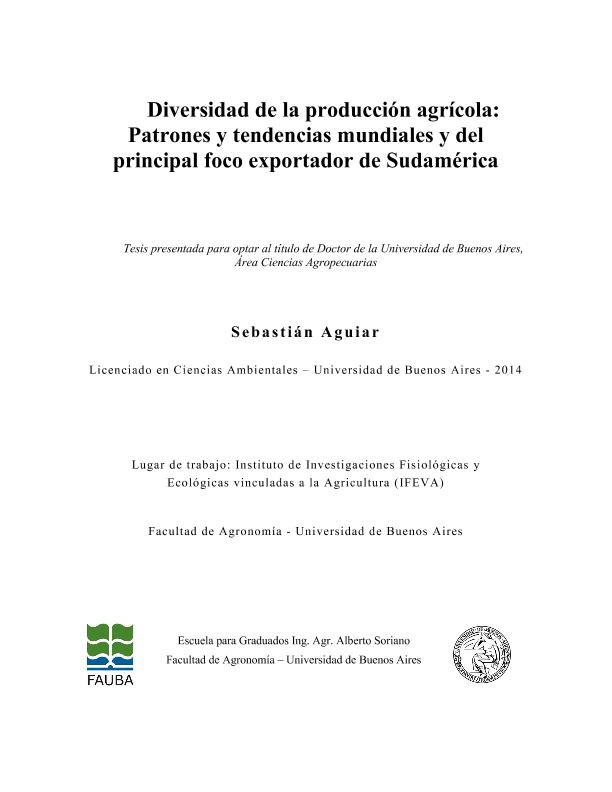Tesis doctoral
Cómo lograr la seguridad alimentaria en el futuro, y al mismo tiempo minimizar los efectos negativos sobre el medioambiente, se ha convertido en uno de los grandes desafíos que enfrenta actualmente la humanidad. La diversidad de la agricultura ha sido relegada de gran parte de las discusiones en torno a este desafío. El objetivo general de esta tesis fue describir los patrones y tendencias de la diversidad de la agricultura a escala mundial y de uno de los principales focos globales de exportación de alimentos (Argentina, Brasil y Paraguay). La aproximación metodológica involucró principalmente la construcción y análisis de bases de datos espaciales y temporales derivados de diferentes fuentes de información. Se encontró que la diversidad de los cultivos que se producen en el territorio (nivel país) ha cambiado poco durante los últimos 50 años, y el consumo se ha diversificado principalmente debido a un intercambio global de mayor magnitud y diversidad. La diversidad actual de cultivos no reproduce patrones biogeográficos naturales como la relación diversidad-latitud. Por el contrario, su principal patrón geográfico representa un legado histórico asociado, en primer lugar, a la ubicación de los principales centros de domesticación primara y secundaria de los cultivos y, en segundo lugar, al intercambio asimétrico de cultivos durante la expansión colonial de Europa. En conjunto, estas contingencias históricas determinaron que el Viejo Mundo (África, Asia y Europa) sea generalmente más diverso que el Nuevo Mundo (América y Oceanía). La producción de granos creció fuertemente en Argentina, Brasil y Paraguay desde comienzos del siglo XXI. Por el contrario, la ganadería creció relativamente poco, pero experimentó una fuerte expansión sobre ecosistemas naturales. Esta expansión se debió parcialmente a un desplazamiento traccionado por el avance de la agricultura en los núcleos más productivos y con mayor historia de uso agropecuario. En conjunto, esta tesis sugiere que la diversidad de la agricultura es una dimensión fundamental de la seguridad alimentaria, cuya preservación e incremento deberían ser el objetivo de políticas nacionales e internacionales orientadas al uso del territorio. How to achieve food security in the future, and at the same time minimize the negative effects on the environment, has become one of the great challenges that humanity presents today. The diversity of agriculture has been relegated from much of the discussions regarding this challenge. The general objective of this thesis was to describe the patterns and trends of the diversity of agriculture at the global scale and for one of the main export hubs of the world (Argentina, Brazil and Paraguay). The methodological approach mainly involved the construction and analysis of spatial and temporal databases derived from different sources of information. The results showed that the diversity of crop production (country level) has slightly changed during the past 50 years, and that crop consumption has diversified mainly due to an increase and diversification of international trade. Currently, the diversity of produced crops does not reproduce natural biogeographical patterns such as the diversity-latitude relationship. In contrast, its main geographical pattern represents a historical legacy associated, firstly, with the location of the main centers of primary and secondary domestication of crops and, secondly, with the asymmetric exchange of crops during the colonial expansion of Europe. Together, these historical contingencies determined that the Old World (Africa, Asia and Europe) is generally more diverse than the New World (America and Oceania). Grain crop production grew strongly in Argentina, Brazil and Paraguay since the beginning of the 21st century. Conversely, livestock grew relatively little, but experienced a strong expansion over natural ecosystems. In part, this expansion was due to a displacement driven by the advance of agriculture in areas with higher productivity and with longer agricultural history. Overall, this thesis suggests that the diversity of agriculture is a fundamental dimension of food security, and its preservation and increase should be at the top of national and international policies aimed regarding land use and its social-ecological consequences.
Diversidad de la producción agrícola: Patrones y tendencias mundiales y del principal foco exportador de Sudamérica
Título:
Diversity of agricultural production: Patterns and trends at the global scale and for the main export hub of South America
Aguiar, Sebastián

Director:
Jobbagy Gampel, Esteban Gabriel

Codirector:
Garibaldi, Lucas Alejandro

Consejero de estudios:
Texeira González, Marcos Alexis

Fecha de publicación:
12/03/2019
Idioma:
Español
Clasificación temática:
Resumen
Archivos asociados
Licencia
Identificadores
Colecciones
Tesis(IFEVA)
Tesis de INST.D/INV.FISIOLOGICAS Y ECO.VINCULADAS A L/AGRIC
Tesis de INST.D/INV.FISIOLOGICAS Y ECO.VINCULADAS A L/AGRIC
Citación
Aguiar, Sebastián; Jobbagy Gampel, Esteban Gabriel; Garibaldi, Lucas Alejandro; Texeira González, Marcos Alexis; Diversidad de la producción agrícola: Patrones y tendencias mundiales y del principal foco exportador de Sudamérica; 12-3-2019
Compartir



